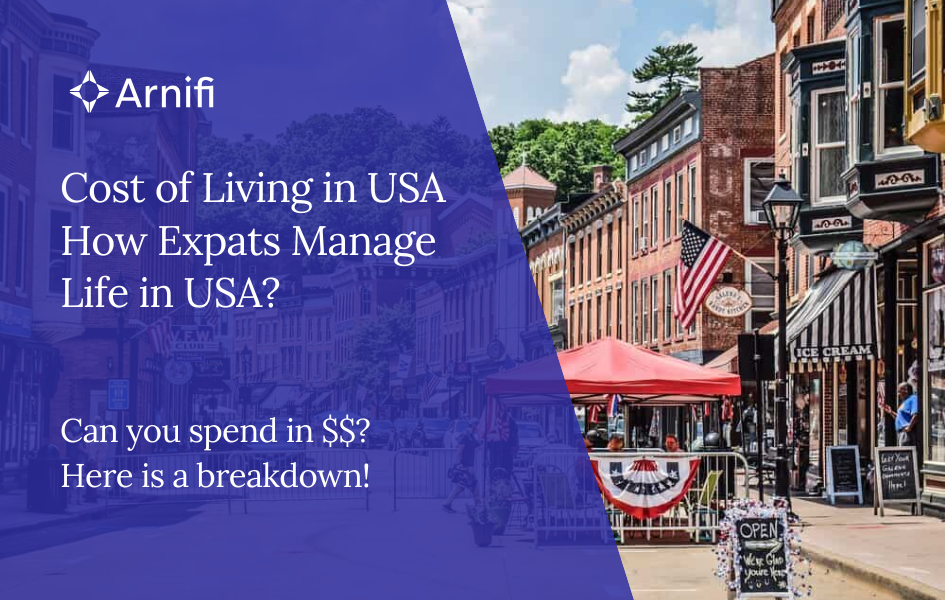Cost of Living in USA | How Expats Manage Life in USA?
by
Shethana
May 22, 2025  6 MIN READ
6 MIN READ

Travelling to the United States is a significant decision, and if you are in the decision-making stage, you are probably wondering: What is the cost of living in the U.S.? It is a pertinent question, without an easy answer.
Table of contents
Cost of living depends tenfold on one’s location, way of living, and what the person’s needs are. That being said, there is a high level of living granted in the U.S., making for stellar infrastructure and an immensely wide range of lifestyle opportunities for expats.
From daily expenses to schooling and leisure-time opportunities, let’s take a look at the real life of a U.S. resident.
Cost of Living & Affordability
Depending largely on what part of the USA you choose to live in, the cost of living will vary accordingly. If you’re heading into big cities like New York, San Francisco, or Los Angeles, be prepared for higher prices-especially for housing. Rental prices can range from $2,500 to well over $4,000 for a modest apartment nicely located in these areas.
But the good news is: not all American cities are expensive. In small cities or in the suburban areas, very good housing choices can be had in the $1,200 to $2,000 per month range- Austin, Raleigh, or the Midwest. These areas often provide a great balance between affordability and quality of life, especially for families.
Utilities, groceries, and public transportation usually vary in each state. Gas is cheaper in Texas than in California, while grocery prices in Florida may favour low prices compared to New York.
Healthcare and education are the other biggest parameters impacting the living expenditure in the U.S., which we’ll discuss shortly.
Expat Communities
No matter where you end up, chances are you won’t be the only expat around. The U.S. has millions of people who’ve moved from other countries. Some cities—like Houston, Chicago, and Miami—are melting pots with huge communities from all over the world.
You’ll find plenty of language support, cultural centres, and expat-focused events. Religious institutions, weekend schools, and social clubs are all over the place, especially in bigger cities. And while English is the main language, you’ll hear Spanish, Arabic, Hindi, Mandarin, and more in many neighbourhoods.
For families, these communities can be a lifesaver. Kids adjust better when they hear their native language spoken or eat familiar food. Adults benefit, too—it’s nice to have a support system when you’re thousands of miles from home.
Healthcare and Medical Access
Let’s be real—healthcare in the U.S. is a mixed bag. The good part? The quality is excellent. Hospitals are clean, high-tech, and staffed with skilled professionals. People from other countries even fly in for complex treatments.
The downside? It’s expensive. Really expensive. If you don’t have insurance, even something simple like a visit to a doctor can cost a few hundred bucks. A trip to the ER? That can run you over $1,000 without blinking.
Most expats get private insurance or are covered by their employer. If you’re self-employed or freelancing, you’ll need to buy your own plan. Some international policies work here, but always check what’s actually covered.
Bottom line—don’t move without insurance. It’s not optional.
Schools and Education Options
If you’re bringing kids with you, schooling will probably be one of your top concerns. The U.S. has a wide range of options. Public schools are free and follow state curriculum. Quality can vary, so it’s worth researching specific districts if you’re picking a place to live.
Private and international schools are available too. Some follow the British or IB systems, and many have strong academic programs. But they don’t come cheap. You might pay $10,000 to $40,000 a year, depending on where you are and the school’s reputation.
All teaching is in English, though some schools offer bilingual programs or ESL (English as a Second Language) support.
Is the U.S. Safe?
This is another one of those “depends on where you are” things. Most suburbs and smaller towns are very safe. Big cities can have rough areas, but not every neighborhood is dangerous. In fact, many are perfectly safe, walkable, and family-friendly.
Police and emergency response teams are usually quick and well-equipped. Most areas also have community policing and neighborhood watch groups.
Before moving, it’s a good idea to research crime stats and talk to locals or real estate agents about which parts of a city are safest.
Entertainment
One of those amazing aspects about living in the U.S. is all the options that line up in front of you. Want some Mother Nature action? There are national parks like Yellowstone and the Grand Canyon. Into something a bit high-end? Well, there are live music concerts, food festivals, sports events, museum exhibits, and many more.
Broadway shows in NYC, jazz festivals in NOLA, tech expos in SanFran… it is endless. There’s always something going on around here!
Food, too, has gained importance here. From food carts to outstanding gourmet restaurants, cuisines belonging to any country of the world can be eaten. Every city has a food culture: for instance, Chicago is famous for deep-dish pizza, while Los Angeles is all about their tacos and sushi.
Final Thoughts | Is It Worth It?
Yes, life in the US comes at some price. Life in the United States can feel quite expensive, especially in bigger cities. However, many expats feel that the quality of life, job opportunities, and all experiences really make it worth it.
The thing is, you have to do your research. Choose your city carefully, make sure you have good health insurance, and try to link up with a local community early on. Those three things alone would have made the process so much smoother.
The U.S., tripping over its diversity, extends lifestyles for all coming here to work, study, or start afresh. Not that the place is perfect, but a lot can be liked if you plan wisely.
If you plan to set up a business in the USA, Get a free consultation now!
Also Read: Cost of living in UAE & how expats handle the cost of living?
Top Usa Packages

Related Articles
Top Usa Packages



